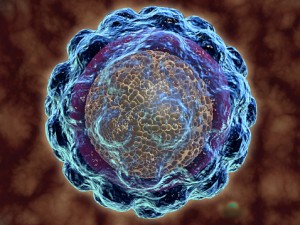Researchers identified a new human virus in serum samples from transfusion recipients. The new virus is related to hepatitis C virus and the human pegaivrus (HPgV, also known as hepatitis G virus).
By using a sequence-independent approach to examine both known and unknown viruses at pre- and post-transfusion, samples from 44 individuals enrolled in the Transfusion-Transmitted Viruses Study from 1974-1980 were compared for changes in viromes pre- and post-transfusion. Two transfusion recipients harbored a new virus called human hepegivirus 1 (HHpgV-1). The new virus was also identified in two hemophilia patients enrolled in the Multicenter Hemophilia Cohort Study, which was conducted between 1982-1986. After sequencing the 9,538-nucleotide genome of HHpgV-1, researchers found that the 5’ untranslated region was similar to pathogenic HCV, and the non-structural genes had similar homology to non-pathogenic HPgV. Further studies are needed to develop a serologic assay for this virus, confirm the prevalence of HHpgV-1 in transfused blood, and determine whether there are any clinical implications of being infected by this virus.
Reference

